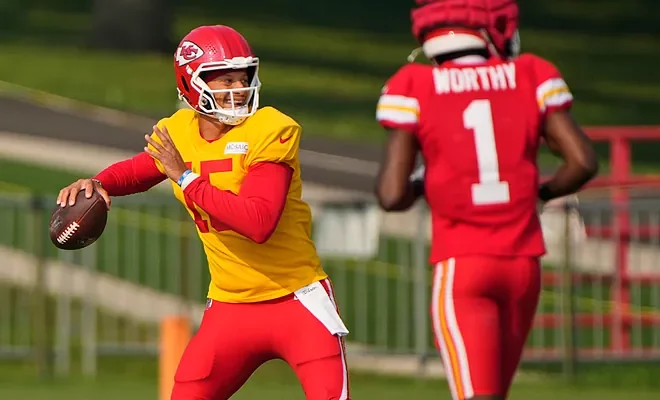The Kansas City Chiefs have never been a team content with resting on their laurels. Ever since Patrick Mahomes stepped into the spotlight as the starting quarterback, he has captivated fans, terrified defenses, and reshaped how the quarterback position is viewed in the modern NFL. With three Super Bowl appearances and two championships under his belt, it would be easy to argue that Mahomes has already reached the pinnacle of football greatness. However, after another grueling season that ended with a hard-fought playoff exit, a growing consensus within the franchise and the league is that something needs to change—not in the form of drastic overhauls to the roster, not a change in leadership or coaching, but rather a necessary adjustment from Mahomes himself that could catalyze yet another Super Bowl run. That change? Patience.
For years, Mahomes has dazzled with his rocket arm, backyard football instincts, and fearless improvisation. He makes throws that defy logic, extends plays like few others in history, and creates something out of nothing. His off-script magic has become both his greatest weapon and his Achilles’ heel. When Mahomes is rolling, the Chiefs offense is unstoppable. But when opposing defenses force him to be methodical, to take what’s given, to resist the urge to go deep or dance around the pocket—it’s then that cracks begin to show. The evolution that must now take place is mental as much as physical. Mahomes needs to embrace the boring. He must learn to dominate not with flair, but with surgical precision, like a master conductor who knows exactly when to build crescendo and when to let the rhythm breathe.
Last season showed that Mahomes can still be elite even in a “down” year. He still threw for over 4,000 yards, maintained a solid touchdown-to-interception ratio, and kept Kansas City competitive in a tough AFC. But the offense no longer had the same aura of invincibility. The loss of Tyreek Hill two seasons ago started to expose certain tendencies. Without the cheat-code speed and gravity Hill brought to the offense, defenses began to flood the deep zones less and crowd the middle of the field more. Cover-2 shells became Mahomes’ constant companion, daring him to be patient, to work underneath, to win the long, slow, methodical way. Sometimes he complied. Other times, frustration crept in. The forced throws, the unnecessary rollouts, the occasional hero ball attempts—they all added up to a unit that sputtered more than it soared.
Andy Reid and Eric Bieniemy, and now Matt Nagy, have long trusted Mahomes to manage the chaos with instinct. But the NFL is a copycat league, and defensive coordinators have finally figured out that the way to beat Mahomes isn’t to blitz or gamble—it’s to wait him out. It’s death by discipline. And now, Mahomes must beat them at their own game. He must become the antidote to the very formula created to neutralize him. That means hitting checkdowns without hesitation. That means stepping up into the pocket instead of drifting backward and inviting pressure. That means identifying the open receiver early and trusting the design of the play rather than waiting for the perfect shot to materialize late. It may not make the highlight reels. It may not sell jerseys. But it wins games. And for Mahomes, winning another Lombardi should now be the only goal.
It’s worth noting that this adjustment is not about curbing Mahomes’ creativity—it’s about refining his judgment. His greatest plays have come when instincts and mechanics are in harmony. The 13-second drive against the Bills. The off-platform laser to Mecole Hardman. The underhand touchdown tosses. The no-look passes. They are all products of a player who sees the game faster than anyone else. But as Mahomes matures, he must also recognize when the defense is begging him to take what’s easy. There is immense power in knowing when not to pull the trigger on a spectacular play. That restraint can be just as dangerous as any deep shot when wielded correctly.
One encouraging sign is that Mahomes has shown flashes of this growth. In several games last year, particularly in matchups against strong defenses like the Jaguars and Bengals, he displayed poise in the pocket and took what was available. He found his tight ends early, used the running backs in the passing game, and moved the chains with consistency. The Chiefs offense looked different in those moments—less flashy, but more efficient. The result was a team that could bleed the clock, wear down defenses, and win ugly. That version of Mahomes is a nightmare for the rest of the league. Because if he ever fully commits to mastering the short game as well as he has the deep and improvisational one, there will be no ceiling on how many more Super Bowls he can win.
The front office has also taken steps to encourage this evolution. The additions of reliable possession receivers, an improved offensive line focused on interior protection, and the continued emphasis on yards-after-catch threats signal a shift in philosophy. Kansas City no longer needs Mahomes to be Superman on every play. They need him to be Tom Brady with a side of magic, not the other way around. It’s a hard ask for a quarterback who has made his name as a generational talent. But it’s also the next logical step in his career arc. Brady, after all, became the greatest of all time not through physical dominance but through ruthless consistency and unmatched mental acuity. Mahomes has the tools to walk that same path—if he chooses to.
There’s also a leadership component to this change. Mahomes is no longer the young phenom trying to earn respect. He is the face of the league, a veteran with a ring for each hand, and the heartbeat of the locker room. His demeanor, his decisions, and his adaptability will ripple through the entire team. If he buys into a more patient style of play, his young receivers will follow suit. The offensive line will block differently knowing the ball is coming out quicker. The running backs will stay engaged, aware that they’re no longer just emergency options but featured tools in the game plan. The coaching staff can call plays with greater confidence, trusting Mahomes to execute the vision with precision.
Defensive players, too, take notice. They know that if the offense can possess the ball longer, the defense stays fresher. The complementary football that Mahomes can enable by simply taking a few more checkdowns and avoiding unnecessary hits has the potential to make the entire team better. It’s a subtle domino effect, but one that begins with the quarterback adjusting not his talent, but his approach.
Of course, this isn’t to suggest that Mahomes abandon who he is. There will always be moments when the Chiefs need him to be the gunslinger, the magician, the force of nature who can snatch victory from the jaws of defeat. That element of his game should remain intact. But by adding this new layer—patience, precision, maturity—Mahomes can become an even more complete quarterback. Think of it as the final piece to an already magnificent puzzle. The greatest quarterbacks in history all evolved. Peyton Manning became a pocket assassin. Drew Brees mastered timing. Aaron Rodgers added ball security and efficiency. Mahomes must now add discipline.
The journey back to the Super Bowl will not be easy. The AFC is stacked. The Bengals, Bills, Ravens, Jets, and others will all be gunning for Kansas City’s crown. But in the biggest moments, the teams that win are the ones that execute. Mahomes already has the intangibles—the swagger, the confidence, the clutch gene. But this new version, the one that methodically carves up defenses, avoids unnecessary risks, and controls the tempo of the game like a master chess player, will be the version that lifts another Lombardi.
The Chiefs still have the infrastructure to be great. Andy Reid remains a play-calling genius. Travis Kelce, though aging, is still a matchup nightmare. The defense is ascending under Steve Spagnuolo. Young talent continues to emerge on both sides of the ball. But their fate rests, as it always has, on the shoulders of No. 15. And if Mahomes can embrace the necessary change—not to reinvent himself, but to refine himself—the Chiefs won’t just return to the Super Bowl. They’ll be favored to win it. Again.



